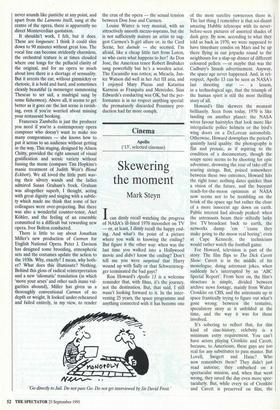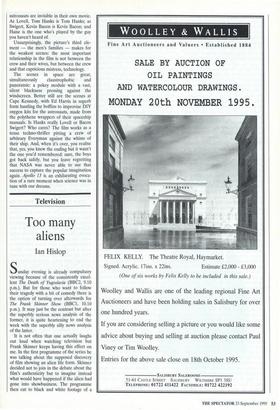Cinema
Apollo (`13', selected cinemas)
Skewering the moment
Mark Steyn
Ican dimly recall watching the progress of NASA's ill-fated 1970 moonshot on TV — or, at least, I dimly recall the happy end- ing. And what's the point of a picture where you walk in knowing the ending? But figure it the other way: when was the last time you walked into a Hollywood movie and didn't know the ending? Don't tell me you were surprised that Harry wound up with Sally or that Schwarzeneg- ger terminated the bad guys?
Ron Howard's Apollo 13 is a welcome reminder that, with films, it's the journey, not the destination. But, that said, I still wasn't looking forward to it. In the inter- vening 25 years, the space programme and anything connected with it has become one `Go directly to Jail. Do not pass Go. Do not get interviewed by Sir David Frost.'
of the most surefire yawneroos there is. The last thing I remember is that soi-disant amazing Hubble telescope with its never- before-seen pictures of assorted shades of dark grey. By now, according to what they told us back in 1970, we were supposed to have timeshare condos on Mars and be up there flying in our jetpacks round to the neighbours for a slap-up dinner of different coloured pellets — or maybe that was the Cadbury's Smash advertisement. Anyway, the space age never happened. And, in ret- rospect, Apollo 13 can be seen as NASA's last shooting star — a lesson, in a technological age, that the triumph of the human spirit is still the most thrilling story of all.
Howard's film skewers the moment brilliantly. Seen from today, 1970 is like landing on another planet: the NASA wives favour hairstyles that look more like intergalactic police helmets or the bird's wing doors on a DeLorean automobile. Otherwise, Howard downplays the period's quaintly lurid quality: the photography is flat and prosaic, as if aspiring to the condition of a documentary, though the soupy score seems to be shooting for epic adventure, drowning the roar of take-off in soaring strings. But, poised somewhere between these two extremes, Howard hits the right tone: nothing dates quicker than a vision of the future, and the buoyant reach-for-the-moon optimism at NASA now seems not to be trembling on the brink of the space age but rather the close of a more innocent age down on earth. Public interest had already peaked: when the astronauts beam their stiltedly larky live TV broadcast back to earth, the networks dump 'em "cause they make going to the moon real boring'; even at Cape Kennedy, the technicians would rather watch the football game.
For Howard, television is part of the story. The film flips to The Dick Cavett Show: Cavett is in the middle of his monologue, doing astronaut jokes, when suddenly he's interrupted by an 'ABC Special Report'. From here on, the film's structure is simple, divided between archive news footage, mainly from Walter Cronkite on CBS, and the astronauts up in space frantically trying to figure out what's gone wrong; between the tentative, speculatory story as it unfolded at the time, and the way it was for those involved.
It's sobering to reflect that, for this kind of cine-history, celebrity is a minimum entry requirement. You can't have actors playing Cronkite and Cavett, because, to Americans, these guys are too real for any substitutes to pass muster. But Lovell, Swigert and Haise? Who now remembers them? They didn't just read autocue; they embarked on a spectacular mission, and, when that went wrong, they saved the day even more spec- tacularly. But, while every tic of Cronkite and Cavett is preserved on film, the astronauts are invisible in their own movie. As Lovell, Tom Hanks is Tom Hanks; as Swigert, Kevin Bacon is Kevin Bacon; and Haise is the one who's played by the guy you haven't heard of.
Unsurprisingly, the picture's third ele- ment — the men's families — makes for the weakest scenes: the most important relationship in the film is not between the crew and their wives, but between the crew and that capricious mistress, technology.
The scenes in space are great, simultaneously claustrophobic and panoramic: a pokey module with a vast, silent blackness pressing against the windscreen. Better still are the scenes at Cape Kennedy, with Ed Harris in superb form hustling the boffins to improvise DIY oxygen kits for the astronauts, made from the polythene wrappers of their spaceship manuals. Is Hanks really Lovell or Bacon Swigert? Who cares? The film works as a tense techno-thriller pitting a crew of arbitrary Everyman against the whims of their ship. And, when it's over, you realise that, yes, you knew the ending but it wasn't the one you'd remembered: sure, the boys got back safely, but you leave regretting that NASA was never able to use that success to capture the popular imagination again. Apollo 13 is an exhilarating evoca- tion of a rare moment when science was in tune with our dreams.



































































 Previous page
Previous page